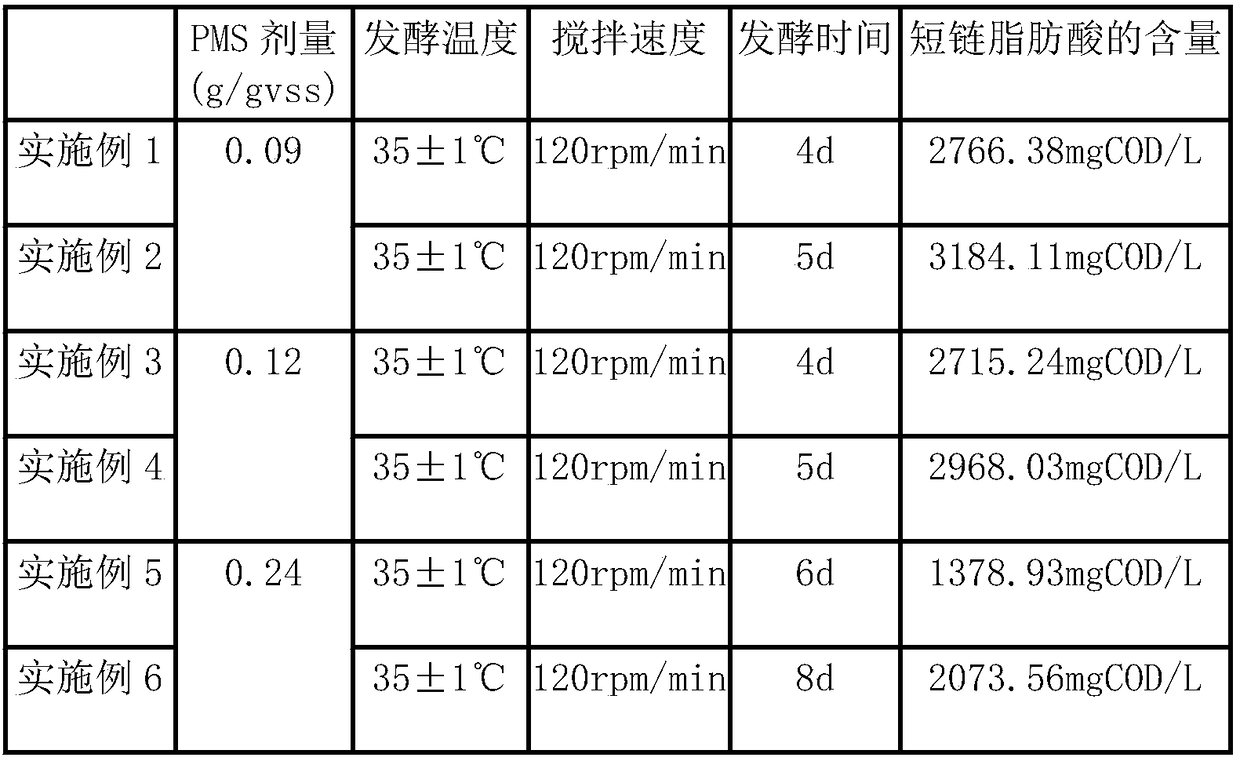Method for promoting residual sludge anaerobic fermentation to produce fatty acid through potassium peroxymonosulfate sulfate compound salt (PMS)
A technology of potassium hydrogen persulfate compound salt and excess sludge, which is applied in the field of short-chain fatty acid production, can solve the problems of serious secondary pollution, large energy consumption, and complicated process control, achieve strong oxidation capacity, and increase the rate of acid production , the effect of reducing environmental pollution
- Summary
- Abstract
- Description
- Claims
- Application Information
AI Technical Summary
Problems solved by technology
Method used
Image
Examples
Embodiment 1
[0024] (1) In a plexiglass reactor with a working volume of 5.0L, the remaining sludge discharged from the sewage treatment plant was naturally precipitated at 4°C for 24 hours, and the supernatant was discarded and concentrated to obtain the required sludge sample. Sludge samples were used as substrates for the production of short-chain fatty acids by anaerobic fermentation;
[0025] (2) Add 0.09g / gVSS potassium monopersulfate compound salt (PMS) to the plexiglass reactor, first stir rapidly at 300rpm for 5min with a magnetic stirrer, and then stir at 150rpm for 90min to fully mix the agent with the sludge. The plexiglass reactor was filled with nitrogen for 1.5min to remove the oxygen therein, and after sealing the plexiglass reactor, put it into a shaker for anaerobic fermentation. The organic matter (mainly polysaccharides and proteins) in the sludge sample is converted into short-chain fatty acids through the joint action of microorganisms in the sludge sample and potassi...
Embodiment 2
[0027] (1) In a plexiglass reactor with a working volume of 5.0L, the remaining sludge discharged from the sewage treatment plant was naturally precipitated at 4°C for 24 hours, and the supernatant was discarded and concentrated to obtain the required sludge sample. Sludge samples were used as substrates for the production of short-chain fatty acids by anaerobic fermentation.
[0028] (2) Add 0.09g / gVSS potassium monopersulfate compound salt (PMS) to the plexiglass reactor, first stir rapidly at 300rpm for 5min with a magnetic stirrer, and then stir at 150rpm for 90min to fully mix the agent with the sludge. The plexiglass reactor was filled with nitrogen for 1.5min to remove the oxygen therein, and after sealing the plexiglass reactor, put it into a shaker for anaerobic fermentation. The organic matter (mainly polysaccharides and proteins) in the sludge sample is converted into short-chain fatty acids through the joint action of microorganisms in the sludge sample and potassi...
Embodiment 3
[0030] (1) In a plexiglass reactor with a working volume of 5.0L, the remaining sludge discharged from the sewage treatment plant was naturally precipitated at 4°C for 24 hours, and the supernatant was discarded and concentrated to obtain the required sludge sample. Sludge samples were used as substrates for the production of short-chain fatty acids by anaerobic fermentation.
[0031] (2) Add 0.12g / gVSS potassium monopersulfate compound salt (PMS) to the plexiglass reactor, first stir rapidly at 300rpm for 5min with a magnetic stirrer, and then stir at 150rpm for 90min to fully mix the agent with the sludge. The plexiglass reactor was filled with nitrogen for 1.5min to remove the oxygen therein, and after sealing the plexiglass reactor, put it into a shaker for anaerobic fermentation. The organic matter (mainly polysaccharides and proteins) in the sludge sample is converted into short-chain fatty acids through the joint action of microorganisms in the sludge sample and potassi...
PUM
 Login to View More
Login to View More Abstract
Description
Claims
Application Information
 Login to View More
Login to View More - R&D
- Intellectual Property
- Life Sciences
- Materials
- Tech Scout
- Unparalleled Data Quality
- Higher Quality Content
- 60% Fewer Hallucinations
Browse by: Latest US Patents, China's latest patents, Technical Efficacy Thesaurus, Application Domain, Technology Topic, Popular Technical Reports.
© 2025 PatSnap. All rights reserved.Legal|Privacy policy|Modern Slavery Act Transparency Statement|Sitemap|About US| Contact US: help@patsnap.com



